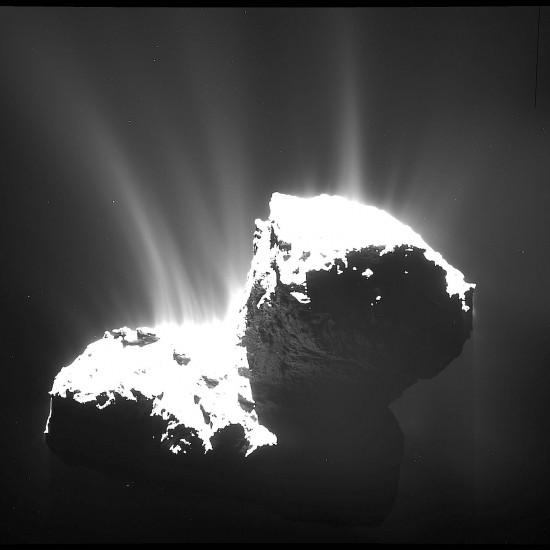
Photogenic comet 67P/Churyumov-Gerasimenko. Credit: ESA/Rosetta/MPS for OSIRIS Team MPS/UPD/LAM/IAA/SSO/INTA/UPM/DASP/IDA
Aug 20, 2015
The “dusty snowball” theory of comets needs attention, since there are crystals that need high temperatures to form in the matrix of at least two.
Recently, the composition of comet 67P/Churyumov-Gerasimenko (67P/C-G) was discussed in the scientific press. It is only in the last few months that dust grain distribution in 67P/C-G’s coma, and an analysis of dust lost from the comet, has been obtained. Other reports indicate a surprising result: minerals that are normally found in conditions similar to a blast furnace are seen in the comet. It is a significant result for Electric Universe advocates.
By way of background, NASA scientists launched the Stardust mission on February 7, 1999. Its primary task was to collect dust particles from the coma of comet Wild 2 and then return to Earth. After a five year journey, Stardust finally intersected Wild 2’s orbit on January 2, 2004, passing through its coma at the metaphorical hair’s breadth distance of 240 kilometers. The aerogel dust-capture system worked perfectly, scooping up fine bits of rock and trapping them inside for their return journey to Earth on January 15, 2006.
After the aerogel was delivered to a team of researchers for analysis, the surprises began. Minerals such as anorthite and forsterite were found embedded in the aerogel—compounds that form only at extremely high temperatures—along with olivine. Perplexed scientists wondered how an object that was supposed to be a remnant from the early nebular cloud out of which the Solar System condensed, and that should have been kept in frozen hibernation in a theoretical “Oort cloud” billions of kilometers from the Sun, could exhibit crystalline structures that would require a blast furnace to create.
Stardust mission team leader Donald Brownlee said at the time, “In the coldest part of the solar system we’ve found samples that formed at extremely high temperatures.”
Electric Universe advocates see things differently. Stars and comets share common characteristics. They are both born of similar parentage: Stars are nodes in vast electrical circuits connected by Birkeland current filaments within galaxies, while planets, moons, asteroids, and comets are electrically charged, existing within a radial electric current that surrounds stars like our own Sun.
Comets, specifically, have nothing to do with an ancient nebular cloud of cold gas and dust that became gravitationally unstable and collapsed into the Solar System of today. Comets and their asteroid sisters are relative newcomers to the solar family and might have been blasted out of larger bodies by tremendously powerful electric discharges in the recent past. They are not “snowballs” or blobs of muddy slush, they are solid, rocky, cratered, electrically charged objects. Whatever water or hydroxyl compounds that can be found in cometary comas is created there, since ionized oxygen from the comet reacts with hydrogen ions streaming out from the Sun. No “jets” of water vapor spew from comets, and no icy plains have ever been observed. It is electric effects that are seen—discharges and arcs form the comet phenomena.
Stephen Smith












